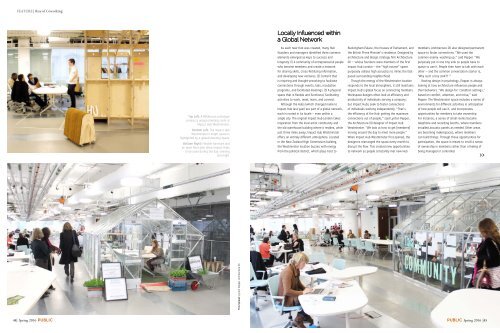RISE OF
s5s9301dTph
s5s9301dTph
You also want an ePaper? Increase the reach of your titles
YUMPU automatically turns print PDFs into web optimized ePapers that Google loves.
FEATURE | Rise of Coworking<br />
Locally Influenced within<br />
a Global Network<br />
Top Left: A WikiHouse prototype<br />
creates a unique meeting room at<br />
Impact Hub Westminster.<br />
Bottom Left: The Impact Hub<br />
Westminster's bright space is<br />
highlighted by a glazed meeting space.<br />
Bottom Right: Flexible furniture and<br />
an open floor plan allow Impact Hubs<br />
to be used during the day, evening<br />
and night.<br />
As each new Hub was created, many Hub<br />
founders and managers identified three common<br />
elements emerged as keys to success and<br />
longevity: (1) A community of entrepreneurial people<br />
who become members and create a network<br />
for sharing skills, cross-fertilizing information,<br />
and developing new ventures. (2) Content that<br />
is inspiring and thought-provoking to facilitate<br />
connections through events, labs, incubation<br />
programs, and facilitated meetings. (3) A physical<br />
space that is flexible and functional, facilitating<br />
activities to work, meet, learn, and connect.<br />
Although the Hubs (which changed name to<br />
Impact Hub last year) are part of a global network,<br />
each is rooted in its locale -- even within a<br />
single city. The original Impact Hub London takes<br />
inspiration from the local artist community and<br />
the old warehouse building where it resides, while<br />
just three miles away, Impact Hub Westminster<br />
offers an entirely different atmosphere. Located<br />
in the New Zealand High Commission building,<br />
the Westminster location buzzes with energy<br />
from the political district, which plays host to<br />
Buckingham Palace, the Houses of Parliament, and<br />
the British Prime Minister<br />
’<br />
s residence. Designed by<br />
architecture and design strategy firm Architecture<br />
00 — whose founders were members of the first<br />
Impact Hub London — the<br />
“ high octane ” space<br />
purposely utilizes high acoustics to mimic the fastpaced<br />
surrounding neighborhood.<br />
Though the energy of the Westminster location<br />
responds to the local atmosphere, it still maintains<br />
Impact Hub<br />
’<br />
s global focus on connecting members.<br />
Workspace designs often look at efficiency and<br />
productivity of individuals serving a company,<br />
but Impact Hubs seek to foster connections<br />
of individuals working independently.<br />
“ That ’ s<br />
the efficiency of the Hub: getting the maximum<br />
connections out of people, ”<br />
said Lynton Pepper,<br />
the Architecture 00 designer of Impact Hub<br />
Westminster.<br />
“<br />
We look at how to get [members]<br />
moving around the day to meet more people.<br />
”<br />
When Impact Hub Westminster first opened, the<br />
designers rearranged the space every month to<br />
disrupt the flow. This created new opportunities<br />
to network as people constantly met new Hub<br />
members. Architecture 00 also designed permanent<br />
space to foster connections.<br />
“<br />
We used the<br />
common enemy: washing up, ”<br />
said Pepper.<br />
“ We<br />
purposely put in one tiny sink so people have to<br />
queue to use it. People then have to talk with each<br />
other — and the common conversation starter is,<br />
‘ Why such a tiny sink?! ’ ”<br />
Rooting design in psychology, Pepper is always<br />
looking at how architecture influences people and<br />
their behaviors.<br />
“ We design for ‘ condition settings, ’<br />
based on comfort, attention, and noise, ”<br />
said<br />
Pepper. The Westminster space includes a series of<br />
environments for different activities in anticipation<br />
of how people will use it, and incorporates<br />
opportunities for members to take ownership.<br />
For instance, a series of small rooms became<br />
telephone and recording booths, where members<br />
installed acoustic panels as needed. Other areas<br />
are becoming makerspaces, where members<br />
can build things. Through these opportunities for<br />
participation, the space is meant to instill a sense<br />
of ownership in members rather than a feeling of<br />
being managed or controlled.<br />
>><br />
This Spread: Lynton Pepper, Architecture 00<br />
44| Spring 2016 PUBLIC PUBLIC Spring 2016<br />
|45


